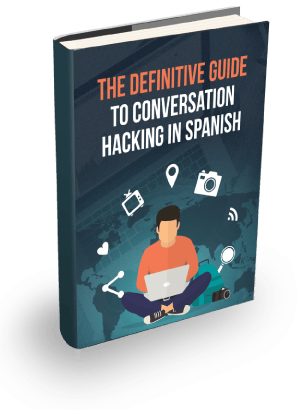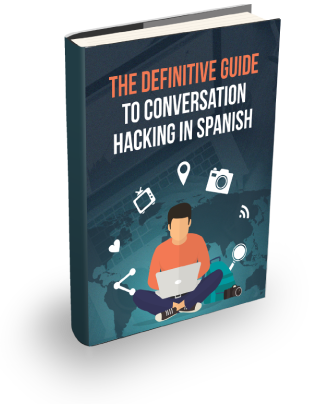Spanish listening skills is one of the toughest sets of skills I ever had to develop. It took a lot of pain over a number of years for me to work out the secret.
When you are reading written Spanish to improve vocabulary or grammar, you have time to assess word meaning, sentence structure and context.
If you recognize a word but can’t remember the meaning, you can stop and think about it. You can think back to when you first learnt the word. You can think of any associations you made to remember it. If you haven’t seen a word, you have time to assess context and guess meaning. And if worst comes to worst you can look the word up in a dictionary.
When you first start to train your listening skills you have to start over.
First, you need to hear the sounds of the language. Then you need to associate those sounds with words you already know and understand on paper.
It could be that you hear an entire sentence of which you understand nothing. But, if that sentence was written down you would understand every word.
Second, once you have established a base of words you recognize in sounds, you need to develop an ability to process those words at native speaking pace and determine meaning as the speaker is talking.
It could be that despite your understanding of every individual word there is still a delay before you can process meaning.
Third, once you have heard a few sentences and understood them, if required, you will have to respond quickly in return.
Without doubt, listening is tough and I envy the students for which this skill comes easy. But, for those that struggle there are ways to improve.
What approach could you take to improving your listening comprehension?
A common recommendation is passive listening. A lot of courses and texts recommended passively listening to a recording or audio. The technique implies that over time you will improve.
Passive listening recommends that you listen while you drive to work, in bed, or doing the dishes.
The idea is that through the process of prolonged exposure you will gradually get used to hearing the sounds and over time begin to recognize them.
This did not work for me.
Before my first trip to Spain in 2010, I had spent a lot of time passively listening to recordings of music, news, movies and dialogue.
I remember getting off the plane in Madrid and asking an official for directions into to town. I asked in Spanish and so they answered in Spanish. And as I had practiced over and over again, I passively listened and hoped that the meaning of what was said to me would sink in.
It didn’t.
I must have stood there staring at the official for 30 seconds before I realized how awkward the situation was. So I thanked him and walked off.
My next awkward encounter was in a tapas bar. I knew from context that the waitress was asking me if I wanted something to eat or drink. This was, of course, because I was standing in a restaurant. But when she spoke, again, I passively stood there. I thought I had time to absorb what was being said and that eventually it would make sense.
It would have been better if I had just said ‘no hablo español‘ than just sit and stare and hope for the best.
Passively listening is doesn’t prepare you for Spanish conversation. You can’t afford to stand and stare while the other person waits.
What is active listening?
Active listening is the process where you hear something and take an action based on what you have heard. It forces you to interpret what you hear and respond, as you would in a conversation.
When you actively listen you are not sitting and hoping the sounds will make sense. You are actively looking for meaning. You are pushing yourself to take a role in interpreting the sounds. So that you can take action as soon as you hear them.
You are not relaxed or multitasking, driving or out for a run. You are focused. You are in the moment and ready to respond.
The best form of active listening practice is actually having a conversation with someone in Spanish. You are actively engaging in an exchange of information and you are forced to take an active role in the direction of the conversation.
If you aren’t ready to take the leap and start practicing with someone in Spanish then you should try Fluent Spanish Listening. It’s a program in the Real Fast Spanish School that is designed to improve your Spanish listening skills through active listening exercises. Every day you will get access to a new Spanish audio. After each audio, you will be tested and asked to answer a set of multiple-choice questions. This forces you to actively engage with what you are listening to. It also doesn’t matter if you make a mistake.
Whether you are ready to start conversing with someone in Spanish or not if you want to improve your listening skills you need to focus on active engagement in what you are listening to. If you are listening to Spanish while you fall asleep or driving to work you might find, as I did, that this kind of practice does not prepare you for interacting with another person.
When you start out, make sure when you are listening that you are always looking to actively engage. Make sure you are looking for meaning and specific pieces of information in which you can make a decision or act.
If you are listening to audio look to write something down. If you are conversing always look to be able to say something back. This active practice will prepare you for the situation where you are asked something that you didn’t expect and be better prepared to respond.
How else can you use active listening to improve your Spanish listening skills?





Hi, great article, though I think that for passive listening you shouldn’t just listen to spanish, I think that first you have to know the meaning of what you are listening and then you should listen for some time and over time try to tell what you were listening on your own words. I wouldn’t even call it passive listening if you do that.